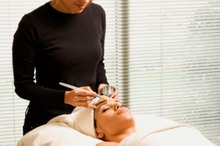Photofacial Vs. Peel
Photofacials and chemical peels are cosmetic procedures that deliver many of the same benefits 3. They both can address skin hyperpigmentation issues as well as fine lines and shallow scarring. However, while a photofacial can treat skin flushing issues caused by broken capillaries and rosacea, a chemical peel can correct deeper wrinkles such as forehead creases and nasolabial folds 1.
Procedure
The photofacial procedure uses a high-intensity, multiple wavelength light beam that can penetrate through all levels of the skin 1. Excess pigment deposits within the epidermis and stagnant hemoglobin in broken capillaries absorb the light from the procedure. This causes the pigment deposits to break apart and the capillaries to constrict, which reduces discoloration. During a chemical peel, a dermatologist applies an acidic peeling agent that exfoliates the upper layers of the skin and causes them to peel away, revealing the healthier, more vibrant skin cells underneath 2. Chemical peels can be administered in various levels of potency and the results depend upon the level of aggressiveness used 3. Significant wrinkling and discoloration require a moderate or deep peel to show improvement, says the American Academy of Dermatology.
Invasiveness
Chemical Peels & Hydroquinone
Learn More
Photofacials are non-invasive and patients can return to work the same or the following day. You may experience some mild discomfort during the procedure that feels like the momentary snapping of a rubber band against your skin. Superficial and moderate chemical peels can also generate mild discomfort in the form of stinging or burning, and these treatments do require some recovery time 3. During a deep peel, general anesthesia is administered while the dermatologist applies a potent acid that reaches deep into the middle layer of the skin. Deep peels are often conducted in an outpatient surgery center and they require significant post-treatment recuperation.
- Photofacials are non-invasive and patients can return to work the same or the following day.
- Superficial and moderate chemical peels can also generate mild discomfort in the form of stinging or burning, and these treatments do require some recovery time 3.
Side Effects
Photofacials can cause a few mild side effects that include redness or swelling, which usually subside in one to three days. On rare occasions, bruising or blistering, infections or scarring can also occur. Chemical peels also present a risk of side effects, and the more invasive the peel, the greater the risk 3. Darker skin types can experience a temporary or permanent discoloration of skin after a peel. Chemical peels can also cause skin redness that can last for several months 3. Infection and scarring are possible, as well. However, properly caring for the treated area after the procedure greatly reduces the risk associated with having a chemical peel.
- Photofacials can cause a few mild side effects that include redness or swelling, which usually subside in one to three days.
Frequency and Cost
Side Effects of a Chemical Face Peel
Learn More
University of Texas physicians recommend a series of three to five photofacial treatments to get the best results 1. As of 2013, a photofacial session is between $300 to $600 per treatment 1. For a chemical peel, the American Academy of Dermatology suggests three to five superficial peels for optimal results, while a medium peel is often administered twice, spaced several months apart 3. The price for a superficial peel runs from $150 to $300, and a medium peel can cost from $1,000 to $2,000. You may undergo a deep chemical peel only once in your life, and the cost can reach $5,000 or higher.
Precautions
Both procedures induce extra sun sensitivity, so use sufficient sunscreen while outdoors. Moderate and deep chemical peel recipients must avoid sun exposure as well as smoking during the healing process. Photofacials are not recommended if you are pregnant, have an autoimmune or connective tissue disease or have taken Accutane in the past six months. Before a chemical peel, let your doctor know if you scar easily, get frequent cold sores or have ever taken isotretinoin, as these conditions may increase the potential for side effects.
- Both procedures induce extra sun sensitivity, so use sufficient sunscreen while outdoors.
- Before a chemical peel, let your doctor know if you scar easily, get frequent cold sores or have ever taken isotretinoin, as these conditions may increase the potential for side effects.
Related Articles
References
- Docshop: IPL Photofacial
- Skincare Physicians: Chemical Peeling
- Smart Skincare: Chemical Peels
- O'connor AA, Lowe PM, Shumack S, Lim AC. Chemical peels: a review of current practice. Australas J Dermatol. 2018;59(3):171-181. doi:10.1111/ajd.12715
- Castillo DE, Keri JE. Chemical peels in the treatment of acne: patient selection and perspectives. Clin Cosmet Investig Dermatol. 2018;11:365–372. doi:10.2147/CCID.S137788
- Soleymani T, Lanoue J, Rahman Z. A practical approach to chemical peels: a review of fundamentals and step-by-step algorithmic protocol for treatment. J Clin Aesthet Dermatol. 2018;11(8):21–28.
- Cleveland Clinic. Chemical peels: what to expect.
- Cleveland Clinic. Chemical peels: how to prepare.
- Stanford Healthcare. Techniques: our approach to chemical skin peels.
- Cleveland Clinic. What results can I expect?.
Resources
Writer Bio
Based in Los Angeles, Claire McAdams has been writing professionally since 2006. Her work has appeared in "The Tennessean" and also online at MaestroCompany.com and SoCal.com. She holds a Bachelor of Music Degree from Belmont University and a Bachelor of Arts Degree in History and Political Science from King College.








